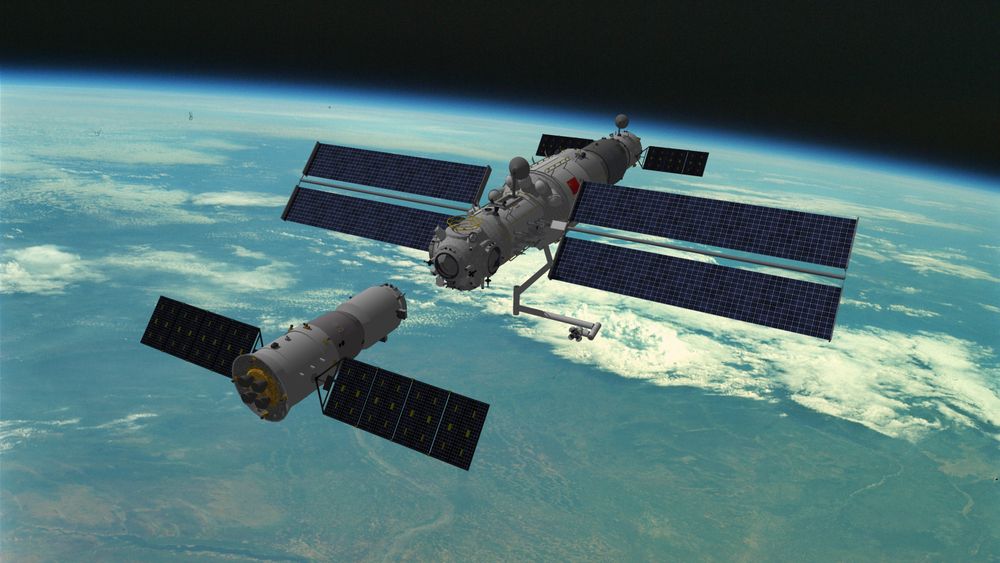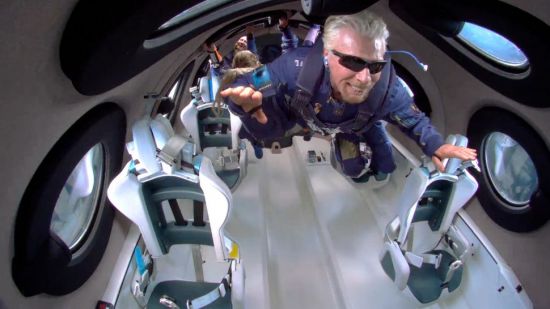Outer space, once a peaceful zone of collaboration, has become crowded, competitive, and even conflict-ridden. One group of countries under US leadership has called for transparency and confidence-building measures, whereas China and Russia posit that only legal measures can deal with existing and emerging challenges in space. Rajeswari Pillai Rajagopalan of the Centre for Security, Strategy and Technology at the Observer Research Foundation in New Delhi, argues that the two groups need to meet halfway.
More than 80 state and non-state players are active in outer space: China's Shenzhou-12 spacecraft docking with the Tianhe space station on June 17, 2021 (Credit: Illustration by Axel Monse / Shutterstock.com)
The outer space domain has changed in significant ways over the past decade and a half. Growth in the number of actors and the diversification of players involved in outer space are driving some of the big changes. Outer space – from about 100 miles above the Earth and beyond the point where atmosphere alone is not enough to support a flying vehicle at suborbital speeds – used to be dominated by a handful of states with government-run programs. But today there are more than 80 players active in the domain, and these include a growing number from the private sector. Within a span of two weeks, two billionaires – Richard Branson of Virgin Galactic and Jeff Bezos of Blue Origin – made historic suborbital flights, pushing open the envelope of space tourism.
These escapades have also opened new issues such as the definition of an “astronaut” and whether it includes the passengers of these two much-hyped flights. There are also developments pertaining to lunar and interplanetary missions. China’s first solo interplanetary mission, Tianwen-1, consisting of an orbiter, lander and rover, successfully entered orbit around Mars in February 2021. Meanwhile, the United Arab Emirates (UAE) launched its interplanetary mission, Hope, to Mars in 2020, reaching the planet’s orbit in February 2021. The US National Aeronautics and Space Administration (NASA) spacecraft bearing the Perseverance rover and the robotic helicopter Ingenuity landed on Mars on February 18, 2021, on a mission to collect the first-ever sample of Martian rock, among other activities, to last at least 687 days.
Developing global governance measures has not been easy in recent decades. The sharp divisions between countries articulating different perspectives have been part of the problem. The debate has centered on the utility of legal instruments and political agreements. One group of countries led by the US has called for transparency and confidence-building measures (TCBMs), while another set of nations led by China and Russia has argued that only legal measures can deal with the existing and emerging challenges in space.
TCBMs are by and large political agreements that do not have legal validity, but they are important measures that encourage information sharing, openness and transparency. In today’s competitive international security environment, generating trust in each other to work together for the global good is critical. Without confidence, the likelihood of states investing in legal measures, including verification, will remain a distant goal.
TCBMs can instill a process that would push states to share details of each other’s space programs, policies, broad objectives driving individual space pursuits, both within the civilian and military sectors, and aspects of regional and international developments, including by their partners. If countries become more open in terms of spelling out details, even in broad terms, it can be helpful in building up confidence in each other.
The fact is that these treaties and agreements were put in place in a very different security environment, and they are not sufficient in dealing with current and emerging threats in space. Treaty-making was also relatively easier when it was essentially building consensus among a handful of countries. Developing a common shared approach and forging agreement among a large number of space players has proven to be the biggest challenge in shaping the outer-space regime.
Transparency and confidence-building measures vs legal rules
That there is no meeting point or a possible compromise between the proponents of TCBMs and legal measures in the global governance arena continues to be a problem. Legally binding treaty measures are the ideal solution, but trying to achieve comprehensive governance should not get in the way of acknowledging and aiming for what is feasible and realistic. A few parallel steps could be taken which might gradually evolve into an effective legal regime in space.
First, efforts focused on developing norms of responsible behavior could be a good start. Norms have no binding effect but the recent erosion of several norms of responsible behavior in outer space that have prevailed for decades is a destabilizing trend that needs to be halted. Over the past decade, the norm to not interfere in each other’s peaceful activities in space has been broken by increasing incidents of cyber and electronic warfare. The norm to not conduct ASAT tests has similarly been violated for 15 years.
If appropriate steps are not taken to preserve norms, the slippery slope of violations could rapidly turn outer space into an active warzone. Norms can take many forms. For instance, the very norms that have been broken can be taken up as unilateral pledges by countries, or they can be introduced in bilateral or regional security arrangements as political agreements. Countries could reaffirm their positions and commitment to safe, secure and sustainable use of outer space through voluntary, non-binding measures that can gradually build up the required confidence to move towards binding legal rules.
Second, a compromise measure between TCBMs and legal instruments could be pursued in the form of legal TCBMs. These may be a feasible halfway approach that could satisfy both sides. Legally binding TCBMs may be developed through UN Security Council resolutions or a UN Group of Governmental Experts (GGE). Another option is for a group of states, including the key space-faring nations, to develop a code of conduct (CoC) that would list good practices and codify the behavior expected of a responsible space player.
The usual argument against a CoC is that it is completely voluntary. Yet, it is possible to build in national legal obligations even if the code itself consists of voluntary and political measures. For example, even though India objected to the manner in which the UN Security Council “legislated” non-proliferation of weapons of mass destruction (WMD) through a resolution unanimously adopted in 2004, India nevertheless passed a domestic WMD law a year later to comply with the international commitments.
A third option is to take some baby steps towards developing legal measures by kick-starting discussions on the serious dangers facing space security. These deliberations would involve developing shared understanding and definitions of the threats, as well as compliance and verification measures.
For progress, a pragmatic approach
These talks would be time consuming and so a good approach would be to pursue the three process alternatives simultaneously. Progress made in the first two could be enormously helpful in making it easier to have the deeper discussions on dangers to space security.
None of the three processes identified above is going to be without difficulty. The last GGE on the Prevention of an Arms Race in Outer Space in 2018-2019 is a testament to the differences among major space powers. That the GGE did not produce a consensus report at the end of its deliberations reflects the difficult challenges posed in the pursuit of global governance of outer space.
An additional step to revive the process of multilateral engagement is to explore other options such as the establishment of a representative and inclusive Global Expert Group under the United Nations, a process similar to the Intergovernmental Panel on Climate Change (IPCC). A group consisting of developing and developed space powers, with appropriate geographical representation, could debate all the contemporary space security challenges including the weaponization of space, debris, and counterspace capabilities, to name a few of the pressing ones. But an inclusive process that gives due weight to the emerging space players is critical.
The development of effective space governance measures is becoming the most serious challenge in outer-space affairs. Great-power competition and the inability to develop a consensus on challenges and threats mean that there is a continuous erosion of norms and rules, which would make access to outer space problematic in the future.
Further reading:
Rajeswari Pillai Rajagopalan
Centre for Security, Strategy and Technology, Observer Research Foundation
Check out here for more research and analysis from Asian perspectives.




